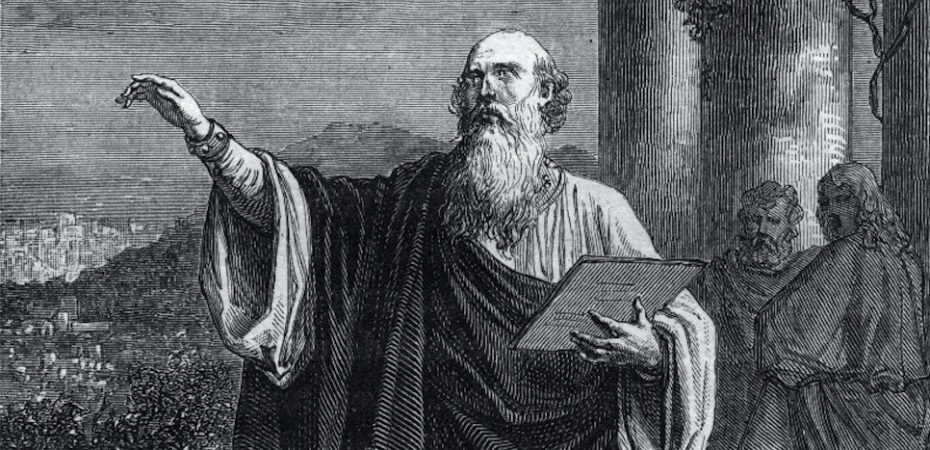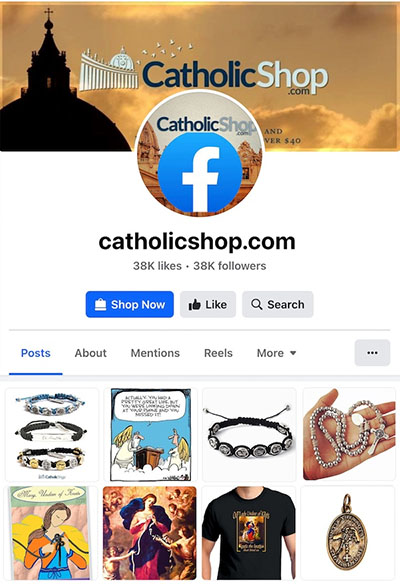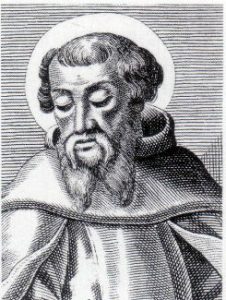
St. Irenaeus of Lyon, a prominent theologian and bishop of the early Christian church, remains a significant figure in the history of Christianity. His most famous work, Against Heresies, is a robust defense of Christian beliefs against the rising threat of Gnostic heresies in the 2nd century. It’s also the source of the Our Lady Undoer of Knots devotion.
This influential work not only sheds light on the challenges faced by the early church but also stands as a testament to the unwavering commitment to preserving the true teachings of Christ.
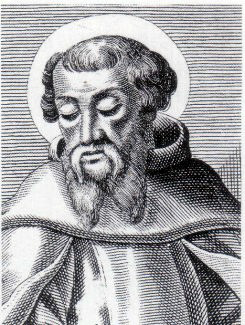 Of particular interest was St. Irenaeus’ comparisons between the Virgin Mary’s role in salvation history and Eve’s disobedience. St. Irenaeus used the contrast to highlight the importance of the Virgin Mary, emphasizing her obedience and faith. One of St. Irenaeus’ examples, in fact, is the inspiration behind the Our Lady Undoer of Knots devotion.
Of particular interest was St. Irenaeus’ comparisons between the Virgin Mary’s role in salvation history and Eve’s disobedience. St. Irenaeus used the contrast to highlight the importance of the Virgin Mary, emphasizing her obedience and faith. One of St. Irenaeus’ examples, in fact, is the inspiration behind the Our Lady Undoer of Knots devotion.
In the 18th century, more than a thousand years after St. Irenaeus wrote Against Heresies, German artist Johann Georg Schmidtner was inspired by Against Heresies (particularly Book III, Chapter 22, Section 4), to paint the famous Our Lady Undoer of Knots painting that depicts the Virgin Mary untying knots in a long ribbon while crushing the head of a serpent. Schmidtner’s painting, in turn, inspired the devotion which has continued to flourish, as noted in our article The Origin of Our Lady Undoer of Knots.
Specifically, Irenaeus wrote: “And thus also it was that the knot of Eve’s disobedience was loosed by the obedience of Mary. For what the virgin Eve had bound fast through unbelief, this did the virgin Mary set free through faith.”
In addition, St. Irenaeus expanded on Our Lady’s role in several other parts of Against Heresies, including this part of the same book and chapter:
“For just as the former (Eve) was led astray by the word of an angel, so that she fled from God when she had transgressed His word; so did the latter (Mary), by an angelic communication, receive the glad tidings that she should sustain (portaret) God, being obedient to His word. And if the former did disobey God, yet the latter was persuaded to be obedient to God, in order that the Virgin Mary might become the patroness (advocata) of the virgin Eve.”
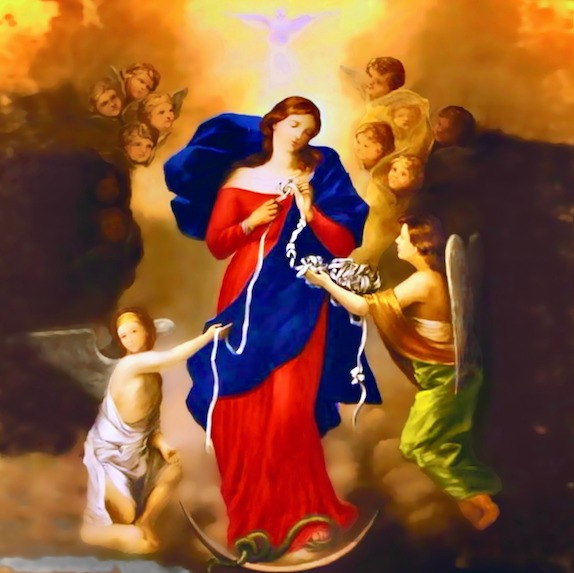
For more about the devotion, see our article The Origin of Our Lady Undoer of Knots.
Also, in Book V, Chapter 19, Section 1, St. Irenaeus wrote: “And again, giving an account of the actions of the same king as having happened among themselves, and of Enoch as having been translated, and of the death of Noah, he [the author of the apocryphal book] falsely added, that “at the same time also, the mother of the Lord, according to the flesh, was born of Anna;” thus holding out to the people an occasion of celebrating her (Mary’s) festival.”
These quotes demonstrate St. Irenaeus’s recognition of the Virgin Mary as a central figure in the story of salvation, highlighting her obedience and faith in contrast to Eve’s disobedience. While there are not a vast number of direct quotes about Mary in Against Heresies, these passages provide a glimpse into the early Christian understanding of her role in salvation history.
The Life of St. Irenaeus
St. Irenaeus, born around 130 AD in Asia Minor, was a disciple of St. Polycarp, who himself was a disciple of St. John the Apostle. Irenaeus later became the bishop of Lugdunum (present-day Lyon, France) and played a vital role in shaping Christian theology during its formative years. His exposure to both Eastern and Western Christianity allowed him to develop a comprehensive understanding of the faith and its core tenets.
The Gnostic Threat
In the 2nd century, the Christian church faced numerous challenges, most notably the spread of Gnostic teachings. Gnosticism, a blend of Christian, Jewish, and pagan beliefs, emphasized secret knowledge as the key to salvation, rather than the redemptive power of Jesus Christ’s crucifixion and resurrection. This deviation from orthodox Christian beliefs posed a significant threat to the unity and stability of the early church.

Against Heresies: A Defense of Orthodoxy
In response to the Gnostic threat, St. Irenaeus composed his magnum opus, “Against Heresies,” also known as “Adversus Haereses” or “On the Detection and Overthrow of the So-Called Gnosis.” This monumental work, written in five volumes, systematically dismantles Gnostic beliefs and defends the authentic teachings of Christianity.
In “Against Heresies,” St. Irenaeus critiques the complex cosmologies and esoteric doctrines of various Gnostic sects. He exposes the inconsistencies in their teachings and counters them with biblical interpretations that affirm the core tenets of orthodox Christianity, such as the divinity of Jesus Christ, the resurrection of the body, and the importance of apostolic tradition.
The work also features an early attempt to establish a canon of Christian scriptures, underscoring the authority of the Old and New Testaments as the inspired Word of God. St. Irenaeus emphasizes the importance of apostolic succession, maintaining that the teachings of the apostles were faithfully passed down through an unbroken chain of bishops.
Lasting Impact
Aside from inspiring the famous Our Lady Undoer of Knots devotion, “Against Heresies” remains a critical work in the study of early Christian theology and the development of orthodoxy. St. Irenaeus’s defense of the faith, grounded in scripture and apostolic tradition, helped to refute Gnostic heresies and preserve the true teachings of Christianity. His unwavering commitment to safeguarding the faith from false doctrines continues to inspire theologians and believers alike, reminding us of the importance of upholding the truth and unity of the church in the face of challenges.
Powerful Quotes
St. Irenaeus was passionate about Christianity, and his powerful words and thoughts give us a window into the depths of his faith. The beautiful, sometimes intense ways in which he illustrated Christian teaching remind us that the Church bore a radical message for Irenaeus’ times. Perhaps the same could be said for our times.
“The glory of God is the human person fully alive.”
“Through a tree we were made debtors to God; so through a tree we have our debt canceled.”
“Error never shows itself in its naked reality, in order not to be discovered. On the contrary, it dresses elegantly, so that the unwary may be led to believe that it is more truthful than truth itself.”
“The business of the Christian is nothing else but to be ever preparing for death.”
“The initial step for us all to come to knowledge of God is contemplation of nature.”
“Since it is impossible, without God, to come to knowledge of God, he teaches men through his Word to know God.”
“As long as any one has the means of doing good to his neighbours, and does not do so, he shall be reckoned a stranger to the love of the Lord.”
“The church has been planted as a paradise in this world.”
The Final Word
In closing, we present Book III, Chapter 22 of Against Heresies in its entirety below, at the end of which you will find the particular section that inspired the Our Lady Undoer of Knots devotion.
Against Heresies (Book III, Chapter 22)
Christ assumed actual flesh, conceived and born of the Virgin.
1. Those, therefore, who allege that He took nothing from the Virgin do greatly err, [since,] in order that they may cast away the inheritance of the flesh, they also reject the analogy [between Him and Adam]. For if the one [who sprang] from the earth had indeed formation and substance from both the hand and workmanship of God, but the other not from the hand and workmanship of God, then He who was made after the image and likeness of the former did not, in that case, preserve the analogy of man, and He must seem an inconsistent piece of work, not having wherewith He may show His wisdom. But this is to say, that He also appeared putatively as man when He was not man, and that He was made man while taking nothing from man. For if He did not receive the substance of flesh from a human being, He neither was made man nor the Son of man; and if He was not made what we were, He did no great thing in what He suffered and endured. But every one will allow that we are [composed of] a body taken from the earth, and a soul receiving spirit from God. This, therefore, the Word of God was made, recapitulating in Himself His own handiwork; and on this account does He confess Himself the Son of man, and blesses the meek, because they shall inherit the earth. Matthew 5:5 The Apostle Paul, moreover, in the Epistle to the Galatians, declares plainly, God sent His Son, made of a woman. Galatians 4:4 And again, in that to the Romans, he says, Concerning His Son, who was made of the seed of David according to the flesh, who was predestinated as the Son of God with power, according to the spirit of holiness, by the resurrection from the dead, Jesus Christ our Lord. Romans 1:3-4
2. Superfluous, too, in that case is His descent into Mary; for why did He come down into her if He were to take nothing of her? Still further, if He had taken nothing of Mary, He would never have availed Himself of those kinds of food which are derived from the earth, by which that body which has been taken from the earth is nourished; nor would He have hungered, fasting those forty days, like Moses and Elias, unless His body was craving after its own proper nourishment; nor, again, would John His disciple have said, when writing of Him, But Jesus, being wearied with the journey, was sitting [to rest]; John 4:6 nor would David have proclaimed of Him beforehand, They have added to the grief of my wounds; nor would He have wept over Lazarus, nor have sweated great drops of blood; nor have declared, My soul is exceeding sorrowful; Matthew 26:38 nor, when His side was pierced, would there have come forth blood and water. For all these are tokens of the flesh which had been derived from the earth, which He had recapitulated in Himself, bearing salvation to His own handiwork.
3. Wherefore Luke points out that the pedigree which traces the generation of our Lord back to Adam contains seventy-two generations, connecting the end with the beginning, and implying that it is He who has summed up in Himself all nations dispersed from Adam downwards, and all languages and generations of men, together with Adam himself. Hence also was Adam himself termed by Paul the figure of Him that was to come, Romans 5:14 because the Word, the Maker of all things, had formed beforehand for Himself the future dispensation of the human race, connected with the Son of God; God having predestined that the first man should be of an animal nature, with this view, that he might be saved by the spiritual One. For inasmuch as He had a pre-existence as a saving Being, it was necessary that what might be saved should also be called into existence, in order that the Being who saves should not exist in vain.
4. In accordance with this design, Mary the Virgin is found obedient, saying, Behold the handmaid of the Lord; be it unto me according to your word. Luke 1:38 But Eve was disobedient; for she did not obey when as yet she was a virgin. And even as she, having indeed a husband, Adam, but being nevertheless as yet a virgin (for in Paradise they were both naked, and were not ashamed, Genesis 2:25 inasmuch as they, having been created a short time previously, had no understanding of the procreation of children: for it was necessary that they should first come to adult age, and then multiply from that time onward), having become disobedient, was made the cause of death, both to herself and to the entire human race; so also did Mary, having a man betrothed [to her], and being nevertheless a virgin, by yielding obedience, become the cause of salvation, both to herself and the whole human race. And on this account does the law term a woman betrothed to a man, the wife of him who had betrothed her, although she was as yet a virgin; thus indicating the back-reference from Mary to Eve, because what is joined together could not otherwise be put asunder than by inversion of the process by which these bonds of union had arisen; so that the former ties be cancelled by the latter, that the latter may set the former again at liberty. And it has, in fact, happened that the first compact looses from the second tie, but that the second tie takes the position of the first which has been cancelled. For this reason did the Lord declare that the first should in truth be last, and the last first. Matthew 19:30, Matthew 20:16 And the prophet, too, indicates the same, saying, instead of fathers, children have been born unto you. For the Lord, having been born the First-begotten of the dead, Revelation 1:5 and receiving into His bosom the ancient fathers, has regenerated them into the life of God, He having been made Himself the beginning of those that live, as Adam became the beginning of those who die. 1 Corinthians 15:20-22 Wherefore also Luke, commencing the genealogy with the Lord, carried it back to Adam, indicating that it was He who regenerated them into the Gospel of life, and not they Him. And thus also it was that the knot of Eve’s disobedience was loosed by the obedience of Mary. For what the virgin Eve had bound fast through unbelief, this did the virgin Mary set free through faith.
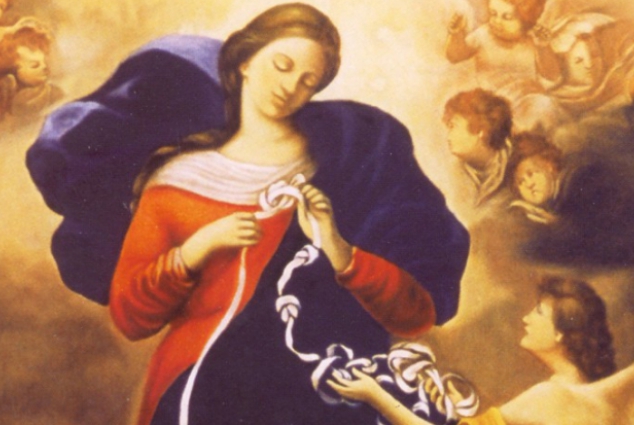
Read next: The Origin of Our Lady Undoer of Knots.

